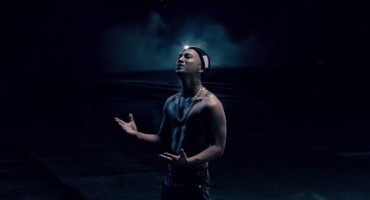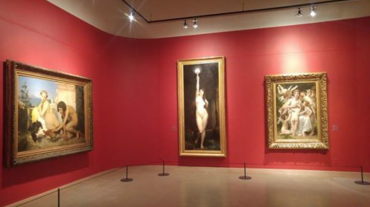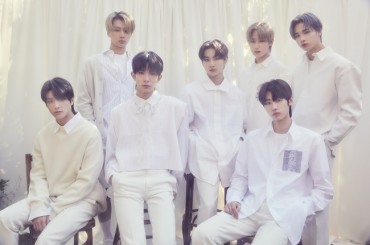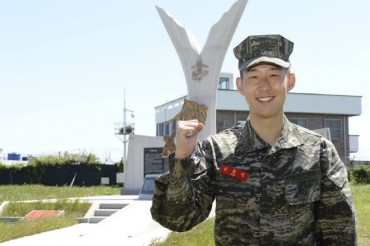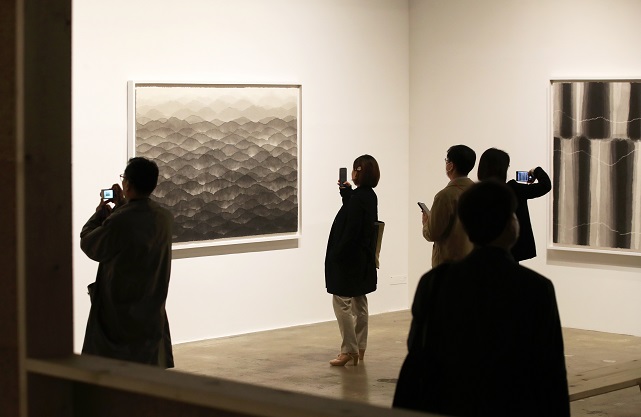
Kim Min-jung’s Korean traditional paintings are displayed during a press preview session for the 14th Gwangju Biennale at the Gwangju Biennale Exhibition Hall on April 5, 2023, two days ahead of its opening. (Yonhap)
GWANGJU, April 6 (Korea Bizwire) — Just like dripping water hollows out stone, not through force but through persistence, art has the power to change narratives and inspire people over time.
Gwangju Biennale, a major art festival in Asia, brings water to the fore for this year’s event to address contemporary social issues and instill translating experiences across space and time.
Themed “Soft and Weak Like Water,” the 14th edition unfolds from April 7 to July 9 across five venues in Gwangju, about 270 kilometers south of Seoul, featuring works by 79 artists from 32 countries.
Artistic director Lee Sook-kyung said she wanted to highlight the spirit of the 1980 Gwangju uprising, a symbol of South Korea’s revolt against military rule, to connect artists around the world to tell stories of their society, history and surrounding environment.
“My curation started from the question of how to view this world as human beings living on this planet,” Lee said during a press briefing at Gwangju Biennale Exhibition Hall, the event’s main venue, on Wednesday.
“Water is a metaphor about things that permeate in a place. Water seems weak but has strong power. Gwangju Biennale takes a metaphorical approach to explore the power of water,” she added.

Woodcut prints of Pangrok Sulap, a Malaysian collective of artists, are displayed during a press preview session for the 14th Gwangju Biennale at the Gwangju Biennale Exhibition Hall on April 5, 2023, two days ahead of its opening. (Yonhap)
For this year’s show, some artists conducted research on the Gwangju Uprising and met bereaved families of victims to portray the spirit of resistance and solidarity in their works.
Pangrok Sulap, a Malaysian collective of artists, presents woodcut prints that reinterpret archival images and documented recordings of people’s lives in Gwangju in the 1980s, inspired by the woodcut movement in the city.
Mexico-born painter Aliza Nisenbaum showcases a series of oil paintings in collaboration with Shinmyeong, a Gwangju-based theater group known for performances that highlight social issues.
Other notable works recount colonial history, disappearing indigenous cultures and diaspora.
Mexican artist Noe Martinez’s ceramic sculptures represent his Huastec ancestors who were trafficked by Europeans in the 16th century.
In front of the installation, the barefoot artist performs a ritual with his own voice and percussion to heal their spirit.
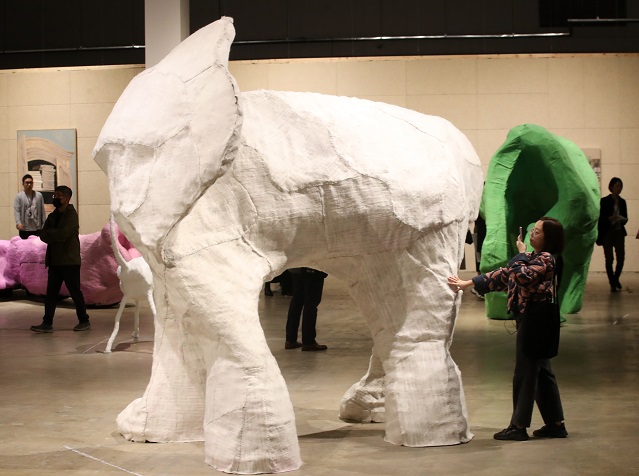
Korean artist Oum Jeong-soon’s sculpture “Elephant without Trunk,” a collaborative project with visually impaired individuals, is displayed during a press preview session for the 14th Gwangju Biennale at the Gwangju Biennale Exhibition Hall on April 5, 2023, two days of its opening. (Yonhap)
Korean photographer Oh Suk-kuhn sheds light on the remnants of Japan’s 1910-45 colonial rule of Korea with photos of Japanese-style houses in Korean port cities, locally known as Jeoksan Gaok, which literally means “enemy houses.”
Works inspired by nature and collaborative projects with handicapped people are also on display.
Kim Min-jung, renowned for Korean traditional painting, features four new works from her ongoing series, titled “Timeless,” “Phasing,” “Mountain,” and “History,” which are created in ink or burned traditional Korean paper, hanji.
Oum Jeong-soon’s “Elephant without Trunk,” a collaborative installation with visually impaired people, casts the question of what it means to perceive things for those who can’t see.
(Yonhap)



